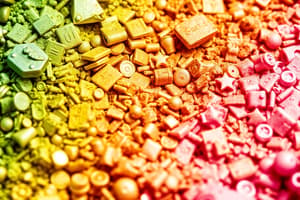Podcast
Questions and Answers
Which of the following is classified as a metal?
Which of the following is classified as a metal?
- Sulfur
- Oxygen
- Copper (correct)
- Phosphorus
Which of these materials is typically a metal?
Which of these materials is typically a metal?
- Bromine
- Helium
- Sodium (correct)
- Neon
Which one of the following is not a metal?
Which one of the following is not a metal?
- Carbon (correct)
- Zinc
- Silver
- Titanium
Identify the non-metal from the following options:
Identify the non-metal from the following options:
Is aluminum typically classified as a metal or a non-metal?
Is aluminum typically classified as a metal or a non-metal?
Would you classify sulfur as a metal or a non-metal?
Would you classify sulfur as a metal or a non-metal?
Is copper generally classified as metal or non-metal?
Is copper generally classified as metal or non-metal?
Is carbon categorized as a metal or a non-metal?
Is carbon categorized as a metal or a non-metal?
Would you classify iron as a metal or a non-metal?
Would you classify iron as a metal or a non-metal?
Flashcards
Metal
Metal
A material that is typically shiny, hard, and can conduct electricity.
Non-metal
Non-metal
A material that is typically dull, brittle, and cannot conduct electricity.
Classify: Silver
Classify: Silver
A material that is typically shiny, hard, and conducts electricity.
Classify: Plastic
Classify: Plastic
Signup and view all the flashcards
Classify: Aluminum
Classify: Aluminum
Signup and view all the flashcards
Study Notes
Classifying Substances as Metals or Nonmetals
- Classification: The process of categorizing substances based on their properties. Materials can be broadly classified as metals or nonmetals.
Key Properties of Metals
- Luster: Metals generally have a shiny or reflective surface.
- Conductivity: Metals are typically good conductors of heat and electricity.
- Malleability: Metals can be hammered or rolled into thin sheets without breaking.
- Ductility: Metals can be drawn into wires.
- High Melting and Boiling Points: Metals generally have high melting and boiling points.
- Density: Metals typically have high densities.
- Strength: Many metals are strong and durable.
- Solids at Room Temperature: Most metals exist as solids at room temperature (exceptions include mercury).
Key Properties of Nonmetals
- Lack of Luster: Nonmetals generally lack a shiny or reflective surface. Often appear dull.
- Poor Conductivity: Nonmetals are typically poor conductors of heat and electricity.
- Brittle: Nonmetals are often brittle and break easily. They are not malleable or ductile.
- Lower Melting and Boiling Points: Nonmetals generally have lower melting and boiling points than metals.
- Varied States of Matter: Nonmetals can be solids, liquids, or gases at room temperature.
Identifying Unknown Substances
- To classify a substance as a metal or a nonmetal, observe its physical properties.
- Test for conductivity, shine, malleability, and ductility.
- If a substance exhibits properties consistent with those of metals (e.g. shine, high melting points, conductivity), classify it as a metal.
- If a substance exhibits properties associated with nonmetals (e.g. lack of shine, low melting points, poor conductivity), classify it as a non-metal.
Examples
- Metals: examples include iron, copper, aluminum, gold, etc.
- Nonmetals: examples include hydrogen, oxygen, chlorine, sulfur, carbon, etc., and bromine.
Important Note
- The classification system is based on general tendencies. Some substances may exhibit properties that are intermediate between those of metals and nonmetals which are called metalloids or semi-metals. This group shares properties of both metals and nonmetals.
Additional Notes
- The provided text about classifying objects as metal or non-metal is not sufficient to add specific examples to the notes. Additional data is needed to properly update the study notes. More examples are needed to create meaningful additions or updates to the current notes.
Studying That Suits You
Use AI to generate personalized quizzes and flashcards to suit your learning preferences.




